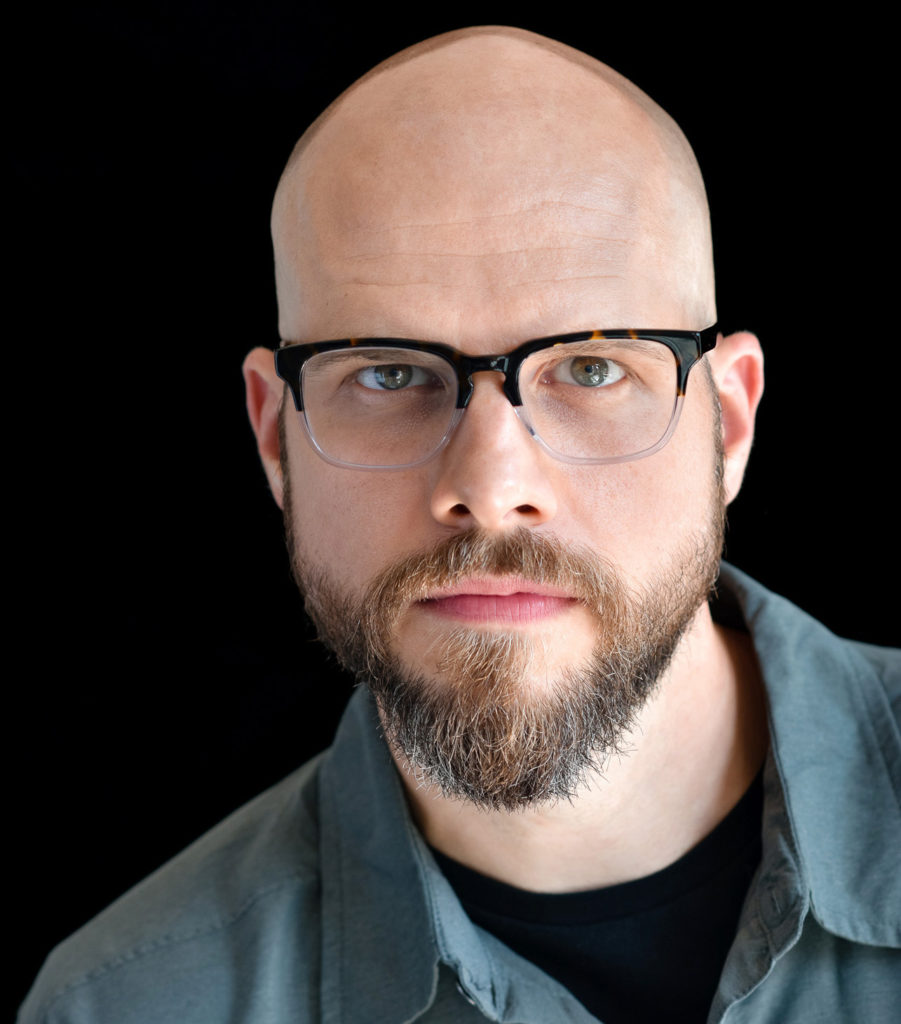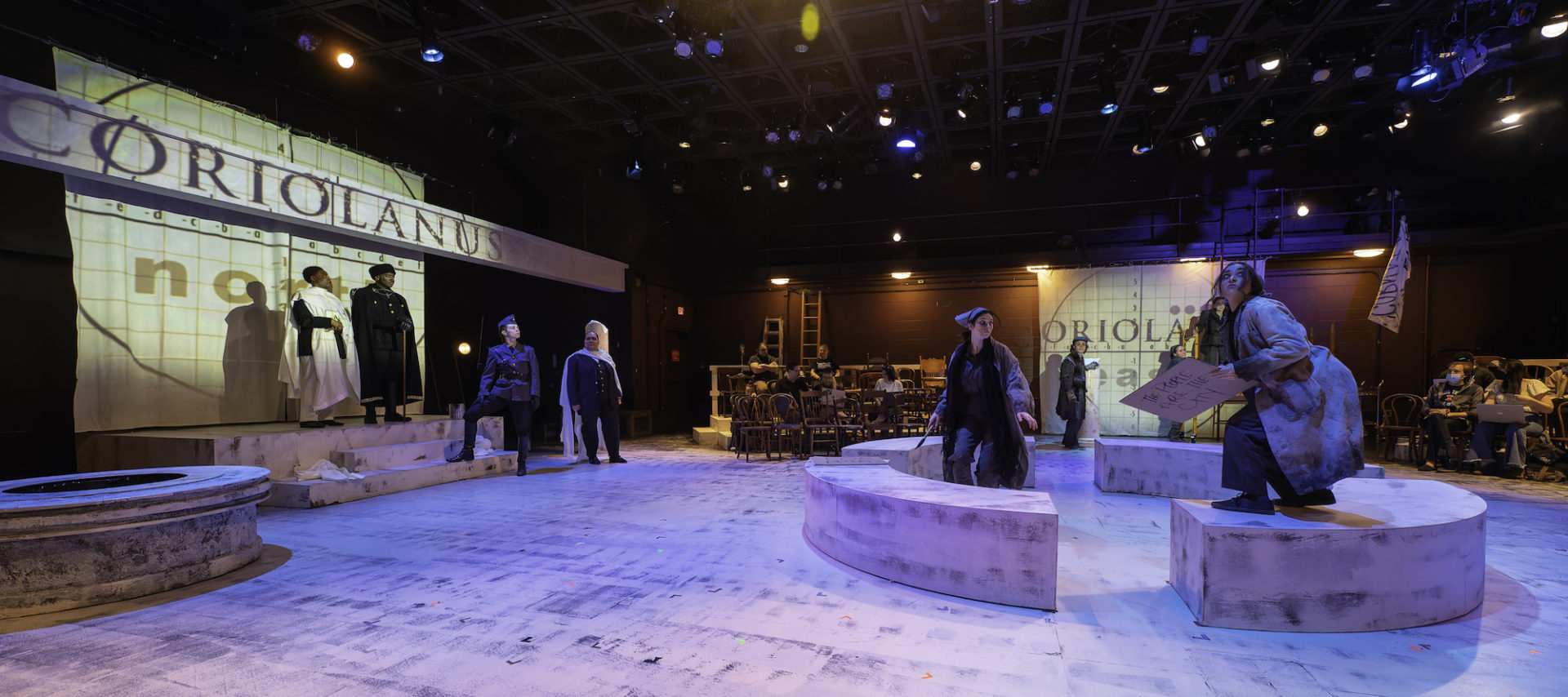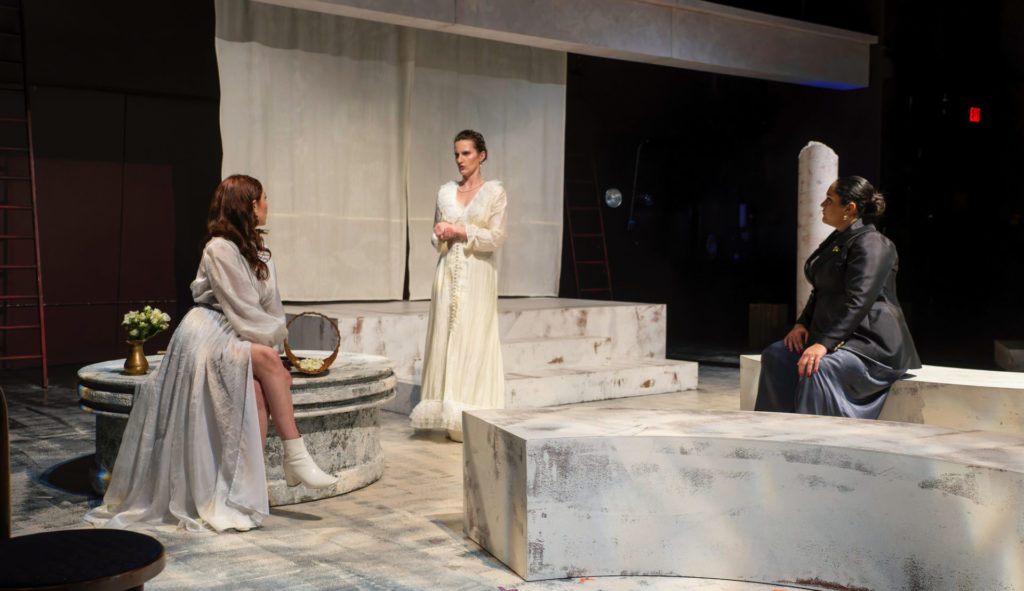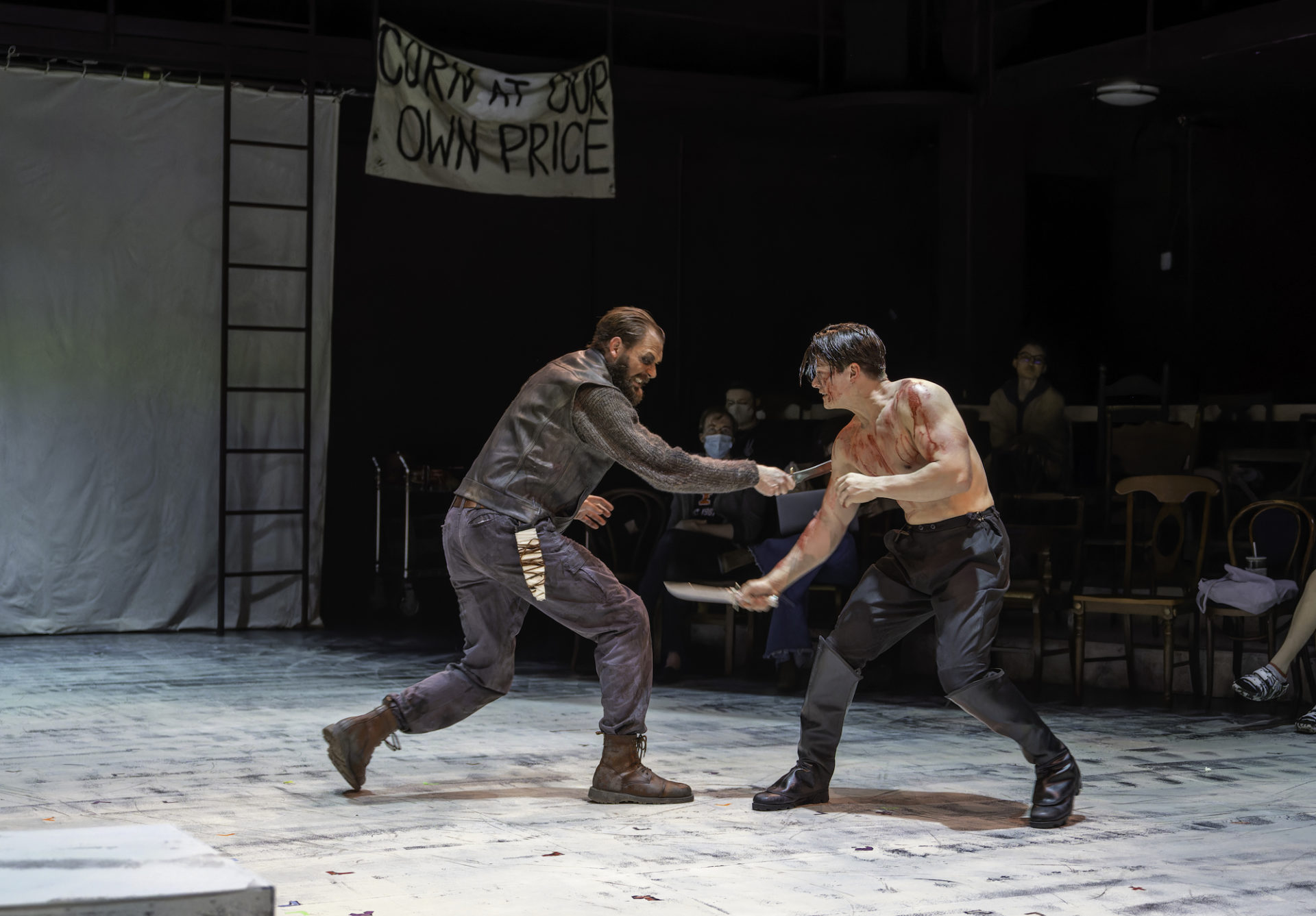On Saturday April 15th, the Studio Theater at Krannert Center for the Performing Arts will open its production of Coriolanus, directed by Robert G. Anderson and adapted by doctoral candidate Vincent Carlson. I caught up with Carlson in the rehearsals leading up to opening night.
Smile Politely: You’re adapting Coriolanus, which is perhaps not the very first title by Shakespeare that people think of. To me, this says that you probably have a significant personal relationship with Shakespeare’s work.
Vincent Carlson: I have a long history with Shakespeare. I was a company member for about 19 years with Nebraska Shakespeare, a professional theater company in Omaha. I was the artistic director there for the last six years. My master’s thesis in British literature was a reconstruction of the Henry VI plays. My PhD research focus is Shakespeare in adaptation. This production of Coriolanus has been a cornerstone of my PhD thesis, and forms a couple chapters of my dissertation, showing the “practice” side of this research.
SP: Before you worked with Nebraska Shakespeare, how did you come to Shakespeare in your life? As a high school student?
Carlson: I think I was introduced to Shakespeare in a freshman [high school] English class, like a lot of folks. We were assigned to read Romeo & Juliet, and I had a really great teacher. We read the play out loud and we watched several productions, which made the experience really great. I was already involved with theater and things, and so I knew that the performance aspect was where it’s at and where the meaning is. Shakespeare never intended for his plays to be read — particularly in a high school classroom 400 years after they were written. They were meant to be performed, and they were written for actors. They’re best when they’re performed, read out loud, and seen, especially when performed by great actors. And that’s what my teacher did for us. From then on, I was hooked.

SP: For someone who maybe isn’t so steeped in Shakespeare — someone who maybe remembers reading Romeo & Juliet in high school, or seeing a handful of film adaptations — what kinds of things do they need to know about Coriolanus when they come to a production like this?
Carlson: Coriolanus is Shakespeare’s last Roman play. It’s a late play in his career, so after all the popular ones like Romeo & Juliet, A Midsummer Night’s Dream, Hamlet, Othello, and the Scottish play, he was experimenting with what he was doing in the plays at this point in time. Coriolanus is the last tragedy before he turned his attention to what we call the Romances, which are fantasy plays and problem plays like Timon of Athens, Pericles, The Tempest, and Two Noble Kinsmen. They’re called “problem plays” not because they are problematic somehow, but because they present a social problem or challenge for the audience. So Coriolanus has an eye toward that same social interrogation.
SP: What is a particularly important theme or question that you’ve drawn out in this adaptation?
Carlson: Shakespeare’s asking his audience, I think, what it means to be a part of a community, or a class system, what it is to have leaders — strong leaders, weak leaders — how to negotiate being manipulated by them, or giving your voice to them for a cause or for the greater good. Coriolanus is about a society, a place calling itself Rome [i.e., Shakespeare’s idea of ancient Rome], in which a strong leader, a military general by the name of Coriolanus, is forced into becoming a politician. It’s not a good fit. Coriolanus is great on the battlefield, and he’s won many victories for Rome, but he’s not so good with political rhetoric and fitting into that role. He has a strong mother who wants him to be that, and a lot of Roman senators forcing him to be that. But there are the people of Rome, the plebians, who have to give him their voice; really the play is about the struggle between the people and their strong leader and what it means to be an individual within the system. Some people call him a tyrant, and some people call a noble leader who doesn’t happen to fit his sphere.
SP: It’s a play about politics and a political system.
Carlson: And my adaptation deconstructs the system. We have a prologue in our play in which two tribunes — common people who have been elected to participate in the senate, which is usually limited to patricians or the upper-class — setting up the play for us. It’s in contemporary language, and they’re giving the audience an idea of what to expect in the play as well as drawing them in to participate more. What’s unique about our production is that we’re asking and inviting the audience to participate, so we’re going to give the audience lines on cue cards and they’re going to give their voices to the play. It’s a play in which we ask you to participate in the system, and therefore become complicit in the end of the play.
SP: I love this idea! It seems like it is well-positioned to ask questions that have a lot of contemporary relevance.
Carlson: Exactly.
SP: Since the production relies on some participation, how have you planned for audience members who maybe were expecting a more one-directional performance?
Carlson: That’s really why the prologue exists — to help acclimate the audience to the production, and in a way to acclimate our actors to the audience that they have as well. We actually rehearse some participation in the prologue in such a way that it gives playgoers more confidence.
SP: What do you think that this approach brings to the table?
Carlson: The idea is that this is sort of a Brechtian piece, and we want the audience to engage with the play instead of sitting back and thinking, “Well, that was a story, and now I’m done.” We want you to engage with the story. We want you to question what’s happening so that when you go back to your own constructed world you can see how changeable it is as well. Exert your voice. Change it. Get involved.

SP: How do you rehearse something like that?
Carlson: It’s borderline improv. We mostly rehearse it by planning for a lot of different responses. A lot of students have friends or family attending, who have presumably been told about at least some of what’s coming. Audiences like that have a lot of willing participants, and those performances are almost like a game. We may also have a few nights where the audience is less responsive, but that’s really the fun thing about theater: you’re relating to the energy in the room. We’ve found when we’ve had designers or guests at rehearsals that people do enjoy the kind of participation that makes a play like this a community event.
SP: What else can you tell me about how you’ve adapted the play, beyond the prologue?
Carlson: In the original there’s a long battle scene followed by a long domestic scene (featuring Coriolanus’s wife). I’ve inter-cut these scenes to make them more episodic. As contemporary audience members we’re used to seeing this technique in film, and I think it makes the play more accessible. It draws different meanings out of the play as well. Because we can see them juxtaposed, we can ask what it means to see and hear Coriolanus’s wife worry about him when we don’t know what the outcome of the battle scene is. In the original, they would have been ten, 12, even 15 minutes apart.
SP: Okay, since there’s a long domestic scene, does this mean that this is a Shakespeare play that passes the Bechdel test?
Carlson: It does!
SP: Yes!
[Interviewer’s note: To pass the Bechdel test, two named female characters must appear and speak to each other about something that is not a man. The purpose of such a test is to assess whether the piece of media in question acknowledges the complexity of its female characters instead of making them two-dimensional foils for a male lead.]
Carlson: More than that, we’ve also cast a lot of women in traditionally-male roles. Menenius, for example, is a Roman senator and a sort of father figure to Coriolanus in the original, and for this role we cast a female MFA actor. We also have a number of gender non-conforming students in different roles. Really, our cast is made up in such a way that it’s really about the characters — this is not a play like Twelfth Night, As You Like It, or The Taming of the Shrew where the plot really hinges on gender. Gender means things in the context of the play, of course, but it’s not a “gender play.” There’s no role-reversal, mistaken identity, or play around the subversity/conformity of gender roles, and it’s allowed us to be freer and more open with our casting. In Coriolanus we have a lot of female or female-presenting actors in all kinds of roles. The two Tribunes, for example, Sasha and MJ, are both female-presenting actors in traditionally-male roles and have really transcended them. They’re some of the most interesting characters in the whole play.

SP: Are your actors who are playing characters whose genders don’t line up with their off-stage presentations playing their characters according to Shakespeare’s genders or their casted ones?
Carlson: It depends. There are some roles in the play where gender is germane to the role. Coriolanus’ mother, for example, is his mother in the original and in our production, and it’s very important to his character that he has a mother and not a father — that will figure importantly in the outcome of the play. Similar character development is true of his wife, Virgilia. There’s a lot of contrast between the battlefield scenes and the scenes of home and family, and seeing Coriolanus move between them tells us a lot.
SP: Oh, you have to tell us about the fight scenes.
Carlson: The aesthetic and the fights are really incredible. It’s not in strictly period or modern dress, but some mixed materials. There’s some 1930s Italy, some 1950s American fashion, and we’re using broadswords and daggers. And Coriolanus is described at one point like a dragon, and the costume designer picked up on that and gave him a long cape. The aesthetic is really Fascist Germany meets Game of Thrones, but then with the weapons you’d expect. We’ve trained from day one with broadswords and daggers; there’s a great battle sequence with ten people beating on each other with broadswords while they’re dodging benches and obstacles and they’re going up and down ladders on a scaffold. Then the sound designer brought in taiko drums to really increase the rhythmic energy.
SP: Do you have a favorite moment, either in the play or that has happened in rehearsal?
Carlson: Oh yeah, I have lots! There’s so much that’s happening. What’s interesting is that our faculty directer Robert Anderson invited me to be on the directing team working with staging pictures and large-scale visuals. I also did the dramaturg work — all the research and background material that we present — and I directed all the fights. While he’s doing a lot of the close-up character and beat work, I get to look at the big picture.
Coriolanus
Krannert Center for the Performing Arts
500 S Goodwin Ave
April 15th, 16th + 18 – 22
Wait list only








